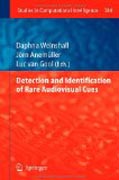
Detection and identification of rare audio-visualcues
Weinshall, Daphna
Anemüller, Jörn
Gool, Luc van
Machine learning builds models of the world using training data from the application domain and prior knowledge about the problem. The models are later applied to future data in order to estimate the current state of the world. An implied assumption is that the future is stochastically similar to the past. Theapproach fails when the system encounters situations that are not anticipatedfrom the past experience. In contrast, successful natural organisms identify new unanticipated stimuli and situations and frequently generate appropriate responses. The observation described above lead to the initiation of the DIRAC EC project in 2006. In 2010 a workshop was held, aimed to bring together researchers and students from different disciplines in order to present and discussnew approaches for identifying and reacting to unexpected events in information-rich environments. This book includes a summary of the achievements of the DIRAC project in chapter 1, and a collection of the papers presented in this workshop in the remaining parts. . Recent research in Detection and Identification of Rare Audiovisual Cues. Scientific outcome of the European project DIRAC (Detection and Identificationof Rare Audio-visual Cues). Written by leading experts in the field. INDICE: Introduction. The DIRAC project. The detection of incongruent events, project survey and algorithms. Alternative frameworks to detect meaningfulnovel events. Dealing with meaningful novel events, what to do after detection. How biological systems deal with novel and incongruent events.
- ISBN: 978-3-642-24033-1
- Editorial: Springer Berlin Heidelberg
- Encuadernacion: Cartoné
- Páginas: 180
- Fecha Publicación: 10/10/2011
- Nº Volúmenes: 1
- Idioma: Inglés
